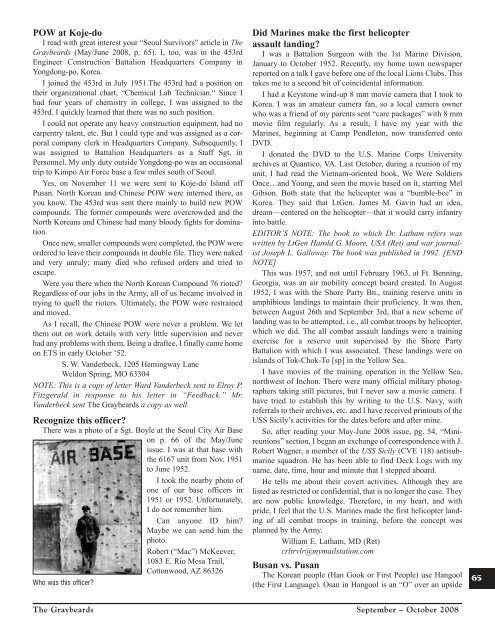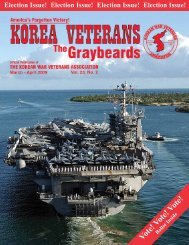Sep/Oct 2008 - Korean War Veterans Association
Sep/Oct 2008 - Korean War Veterans Association
Sep/Oct 2008 - Korean War Veterans Association
Create successful ePaper yourself
Turn your PDF publications into a flip-book with our unique Google optimized e-Paper software.
POW at Koje-do<br />
I read with great interest your “Seoul Survivors” article in The<br />
Graybeards (May/June <strong>2008</strong>, p. 65). I, too, was in the 453rd<br />
Engineer Construction Battalion Headquarters Company in<br />
Yongdong-po, Korea.<br />
I joined the 453rd in July 1951.The 453rd had a position on<br />
their organizational chart, “Chemical Lab Technician.“ Since I<br />
had four years of chemistry in college, I was assigned to the<br />
453rd. I quickly learned that there was no such position.<br />
I could not operate any heavy construction equipment, had no<br />
carpentry talent, etc. But I could type and was assigned as a corporal<br />
company clerk in Headquarters Company. Subsequently, I<br />
was assigned to Battalion Headquarters as a Staff Sgt. in<br />
Personnel. My only duty outside Yongdong-po was an occasional<br />
trip to Kimpo Air Force base a few miles south of Seoul.<br />
Yes, on November 11 we were sent to Koje-do Island off<br />
Pusan. North <strong>Korean</strong> and Chinese POW were interned there, as<br />
you know. The 453rd was sent there mainly to build new POW<br />
compounds. The former compounds were overcrowded and the<br />
North <strong>Korean</strong>s and Chinese had many bloody fights for domination.<br />
Once new, smaller compounds were completed, the POW were<br />
ordered to leave their compounds in double file. They were naked<br />
and very unruly; many died who refused orders and tried to<br />
escape.<br />
Were you there when the North <strong>Korean</strong> Compound 76 rioted?<br />
Regardless of our jobs in the Army, all of us became involved in<br />
trying to quell the rioters. Ultimately, the POW were restrained<br />
and moved.<br />
As I recall, the Chinese POW were never a problem. We let<br />
them out on work details with very little supervision and never<br />
had any problems with them. Being a draftee, I finally came home<br />
on ETS in early <strong>Oct</strong>ober ‘52.<br />
S. W. Vanderbeck, 1205 Hemingway Lane<br />
Weldon Spring, MO 63304<br />
NOTE: This is a copy of letter <strong>War</strong>d Vanderbeck sent to Elroy P.<br />
Fitzgerald in response to his letter in “Feedback.” Mr.<br />
Vanderbeck sent The Graybeards a copy as well.<br />
Recognize this officer?<br />
There was a photo of a Sgt. Boyle at the Seoul City Air Base<br />
on p. 66 of the May/June<br />
issue. I was at that base with<br />
the 6167 unit from Nov. 1951<br />
to June 1952.<br />
I took the nearby photo of<br />
one of our base officers in<br />
1951 or 1952. Unfortunately,<br />
I do not remember him.<br />
Can anyone ID him?<br />
Maybe we can send him the<br />
photo.<br />
Robert (“Mac”) McKeever,<br />
1083 E. Rio Mesa Trail,<br />
Cottonwood, AZ 86326<br />
Who was this officer?<br />
Did Marines make the first helicopter<br />
assault landing?<br />
I was a Battalion Surgeon with the 1st Marine Division,<br />
January to <strong>Oct</strong>ober 1952. Recently, my home town newspaper<br />
reported on a talk I gave before one of the local Lions Clubs. This<br />
takes me to a second bit of coincidental information.<br />
I had a Keystone wind-up 8 mm movie camera that I took to<br />
Korea. I was an amateur camera fan, so a local camera owner<br />
who was a friend of my parents sent “care packages” with 8 mm<br />
movie film regularly. As a result, I have my year with the<br />
Marines, beginning at Camp Pendleton, now transferred onto<br />
DVD.<br />
I donated the DVD to the U.S. Marine Corps University<br />
archives at Quantico, VA. Last <strong>Oct</strong>ober, during a reunion of my<br />
unit, I had read the Vietnam-oriented book, We Were Soldiers<br />
Once…and Young, and seen the movie based on it, starring Mel<br />
Gibson. Both state that the helicopter was a “bumble-bee” in<br />
Korea. They said that LtGen. James M. Gavin had an idea,<br />
dream—centered on the helicopter—that it would carry infantry<br />
into battle.<br />
EDITOR’S NOTE: The book to which Dr. Latham refers was<br />
written by LtGen Harold G. Moore, USA (Ret) and war journalist<br />
Joseph L. Galloway. The book was published in 1992. [END<br />
NOTE]<br />
This was 1957, and not until February 1963, at Ft. Benning,<br />
Georgia, was an air mobility concept board created. In August<br />
1952, I was with the Shore Party Bn., training reserve units in<br />
amphibious landings to maintain their proficiency. It was then,<br />
between August 26th and <strong>Sep</strong>tember 3rd, that a new scheme of<br />
landing was to be attempted, i.e., all combat troops by helicopter,<br />
which we did. The all combat assault landings were a training<br />
exercise for a reserve unit supervised by the Shore Party<br />
Battalion with which I was associated. These landings were on<br />
islands of Tok-Chok-To [sp] in the Yellow Sea.<br />
I have movies of the training operation in the Yellow Sea,<br />
northwest of Inchon. There were many official military photographers<br />
taking still pictures, but I never saw a movie camera. I<br />
have tried to establish this by writing to the U.S. Navy, with<br />
referrals to their archives, etc. and I have received printouts of the<br />
USS Sicily’s activities for the dates before and after mine.<br />
So, after reading your May-June <strong>2008</strong> issue, pg. 54, “Minireunions”<br />
section, I began an exchange of correspondence with J.<br />
Robert Wagner, a member of the USS Sicily (CVE 118) antisubmarine<br />
squadron. He has been able to find Deck Logs with my<br />
name, date, time, hour and minute that I stepped aboard.<br />
He tells me about their covert activities. Although they are<br />
listed as restricted or confidential, that is no longer the case. They<br />
are now public knowledge. Therefore, in my heart, and with<br />
pride, I feel that the U.S. Marines made the first helicopter landing<br />
of all combat troops in training, before the concept was<br />
planned by the Army.<br />
William E. Latham, MD (Ret)<br />
crltrvlr@mymailstation.com<br />
Busan vs. Pusan<br />
The <strong>Korean</strong> people (Han Gook or First People) use Hangool<br />
(the First Language). Osan in Hangool is an “O” over an upside<br />
65<br />
The Graybeards<br />
<strong>Sep</strong>tember – <strong>Oct</strong>ober <strong>2008</strong>

















